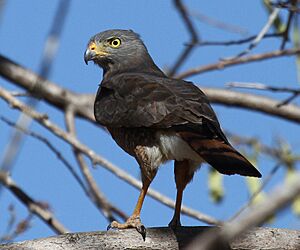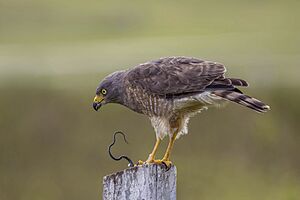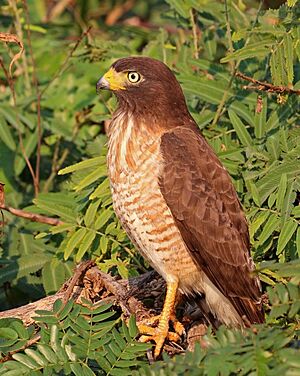Roadside hawk facts for kids
Quick facts for kids Roadside hawk |
|
|---|---|
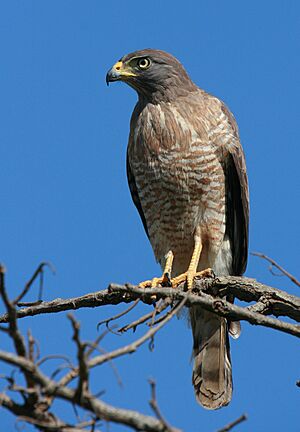 |
|
| In Goiás, Brazil | |
| Conservation status | |
| Scientific classification | |
| Genus: |
Rupornis
|
| Species: |
magnirostris
|
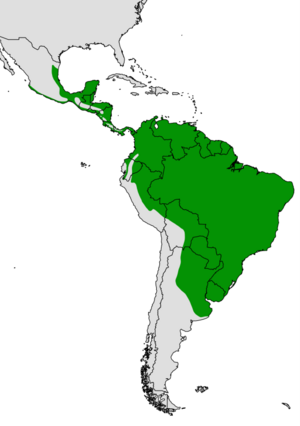 |
|
| Synonyms | |
|
Buteo magnirostris |
|
The roadside hawk (Rupornis magnirostris) is a small bird of prey that lives in the Americas. You can often hear its loud calls. It's one of the most common hawks in its home. This bird has many different types, called subspecies. Scientists now usually place it in its own special group, called a genus, named Rupornis. Before, it was grouped with other hawks in the Buteo genus.
Contents
Understanding the Roadside Hawk's Name
The roadside hawk was first officially described in 1788. A German scientist named Johann Friedrich Gmelin gave it the scientific name Falco magnirostris. He put it in the same group as eagles and other hawks.
Later, in 1844, another German scientist, Johann Jakob Kaup, created a new group just for this hawk. He named this new group Rupornis. The name Rupornis comes from two old Greek words: rhupos, meaning "dirt" or "filth," and ornis, meaning "bird." The second part of its scientific name, magnirostris, comes from Latin words. Magnus means "great," and -rostris means "billed." So, its name basically means "large-billed bird."
Different Types of Roadside Hawks
There are twelve different types, or subspecies, of the roadside hawk. They live in various places across the Americas:
- R. m. griseocauda – Found from Mexico south to northwest Costa Rica and west Panama.
- R. m. conspectus – Lives in southeast Mexico and northern Belize.
- R. m. gracilis – Found on Cozumel and Isla Holbox, islands near Mexico's Yucatán Peninsula.
- R. m. sinushonduri – Lives on Guanaja and Roatán islands, off Honduras.
- R. m. petulans – Found in southwest Costa Rica and western Panama.
- R. m. alius – Lives on San José and San Miguel islands in the Pearl Islands.
- R. m. magnirostris – The main type, found from Colombia south to west Ecuador, east to Venezuela, and south into Brazil.
- R. m. occiduus – Lives in eastern Peru, western Brazil, and northern Bolivia.
- R. m. saturatus – Found from Bolivia through Paraguay and southwest Brazil to western Argentina.
- R. m. nattereri – Lives in northeast Brazil.
- R. m. magniplumis – Found in southern Brazil, northern Argentina, and nearby Paraguay.
- R. m. pucherani – Lives in Uruguay and northeast Argentina.
What Does a Roadside Hawk Look Like?
The roadside hawk is about 31 to 41 centimeters (12 to 16 inches) long. It weighs between 250 and 300 grams (9 to 11 ounces). Male hawks are about 20% smaller than females. But other than size, males and females look very similar.
Most of these hawks have brown and white stripes on their lower chest and belly. Their tail usually has four or five gray stripes. The color of their feathers can change quite a bit depending on the subspecies. They are mostly brown or gray. You might also see a reddish-brown color on their wings, especially when they are flying.
Key Features
Their call is a very loud, high-pitched squeak. Adult roadside hawks have whitish or yellow eyes. As its name suggests, its beak is quite large.
The roadside hawk is one of the smallest hawks in the Buteo group. When it flies, you can easily spot its long tail and shorter wings. It often glides high in the sky but does not hover in one spot.
Where Do Roadside Hawks Live?
The roadside hawk is very common across its home range. This stretches from Mexico, through Central America, and into most of South America east of the Andes mountains. Sometimes, these hawks are even seen in Texas, USA, though this is rare. They live from the northern Caribbean coast of South America all the way south to northeastern Argentina.
These hawks can live in many different places. They are good at adapting to most environments, except for very thick rainforests. They are also city birds! You might see them in many cities across their range. They can become quite protective when they have a nest. They have even been known to act aggressively towards people who get too close to their nests.
Roadside Hawk Behavior and Life Cycle
Reproduction and Nests
Roadside hawks build large nests out of sticks. They line the inside with leaves. These nests are usually placed near the top of a tree. The female hawk lays one or two eggs. She sits on them for about 37 days until they hatch. She starts incubating the eggs after the first one is laid.
What Do Roadside Hawks Eat?
The roadside hawk mainly eats insects, squamates (like lizards and snakes), and small mammals. They often hunt young common marmosets and other small monkeys. They will also catch small birds, but this is less common.
Other birds that hunt in groups don't seem too worried about roadside hawks. They watch the hawk to make sure it doesn't come too close. But they don't see it as a big threat, maybe because it's smaller than other hawks.
How Roadside Hawks Hunt
Roadside hawks often hunt by "still hunting." This means they wait patiently for their prey. When they hunt from a perch, the hawk will drop or glide down from a high spot to catch its prey. This hunting style is often successful. However, how well they hunt can depend on the type of place they are hunting in.



